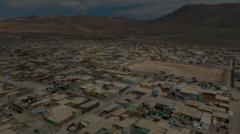In a groundbreaking study, researchers in Chile are exploring the potential of fog harvesting to provide clean drinking water to some of the world's driest cities, specifically focusing on Alto Hospicio. With an average annual rainfall of just 0.19 inches (5mm), the city faces severe water shortages, relying heavily on truck-delivered water for its slum areas.
Dr. Virginia Carter Gamberini, the study's lead researcher from Universidad Mayor, highlights the dual challenge of water scarcity and social issues such as poverty in the city. The solution? Making use of the clouds of fog that accumulate over the coastal mountains.
The process of fog harvesting is quite straightforward: a fine mesh is set up between poles, allowing moisture-laden fog to pass through and condense into droplets that can be collected. This method has been effectively employed on a smaller scale in various regions of South and Central America for decades. One of the most notable fog harvesting systems is located in Morocco, situated on the cusp of the Sahara Desert.
According to Dr. Gamberini, we are on the brink of a new era with large-scale fog harvesting, offering a sustainable source of water in urban areas. Their research utilized satellite data and weather forecasts to quantify how much water could be harvested, showing that the cloud formations over the nearby Pacific Ocean could significantly improve water access for Alto Hospicio's underserved communities.
The findings have promising implications: an estimated 17,000 square meters of fog netting could supply enough water to meet the weekly demand of 300,000 liters currently delivered by trucks, while 110 square meters could sustain city green spaces. Additionally, the harvested fog water could facilitate hydroponic farming, boosting vegetable yields substantially.
As cities like Alto Hospicio face increasing water demand amidst climate change and population growth, Dr. Gamberini emphasizes the urgent need for innovative solutions. Chile's unique geography, with its coastal marine fog and mountainous terrain, makes it an ideal candidate for fog harvesting, with ongoing efforts to create a "fog harvesting map" to identify potential sites across the country.
With this innovative approach, water from the clouds may soon enhance resilience against climate challenges and provide a much-needed lifeline to communities struggling for access to clean water.





















